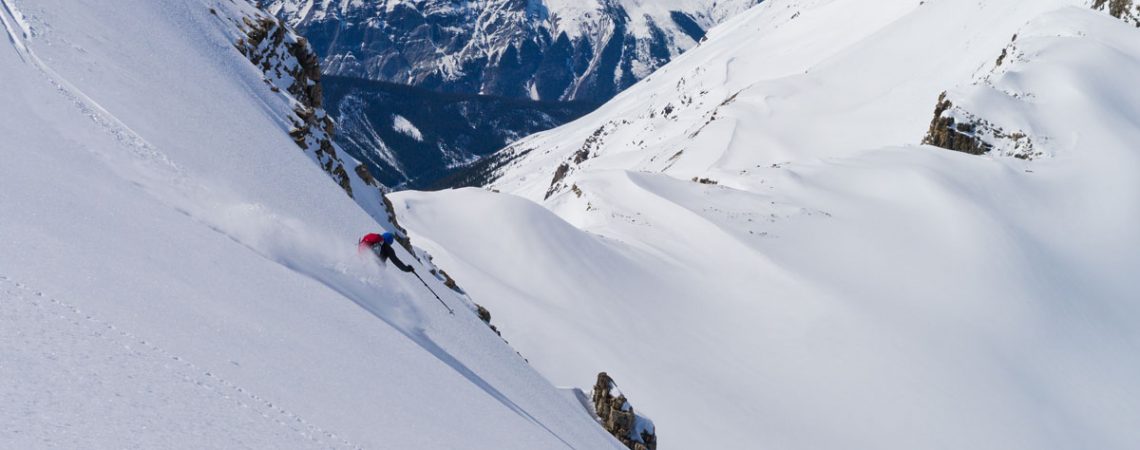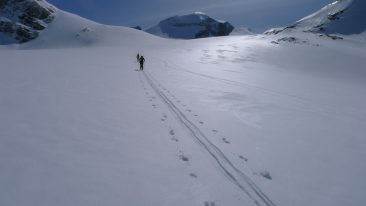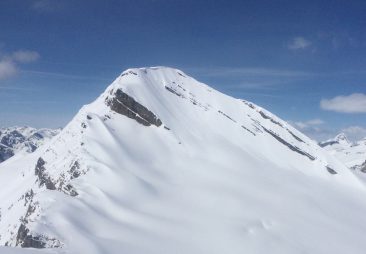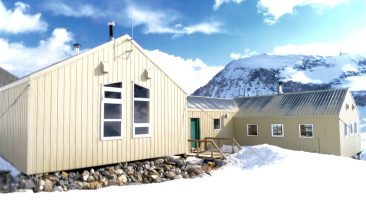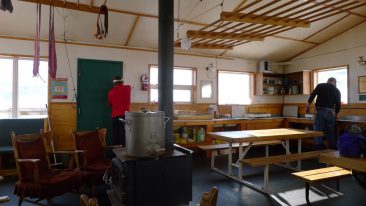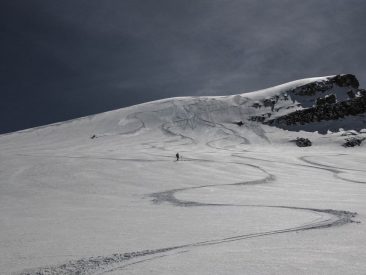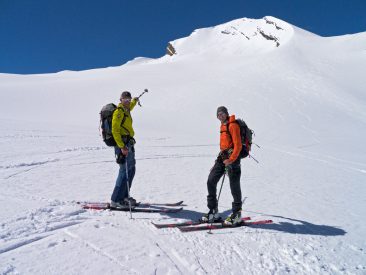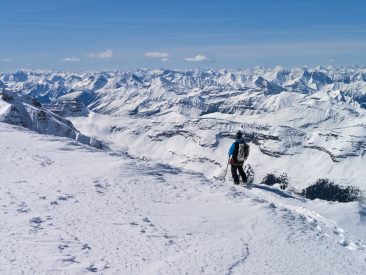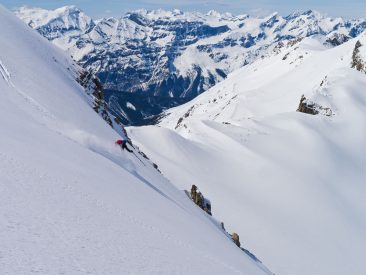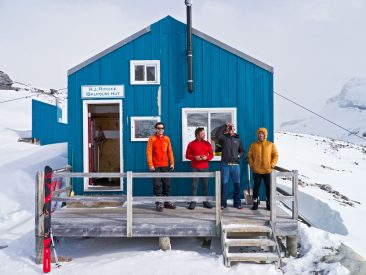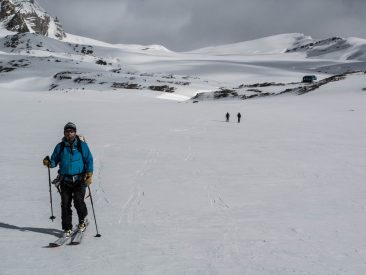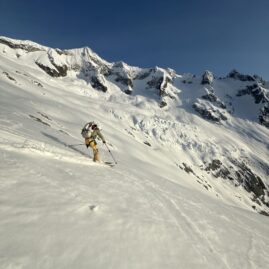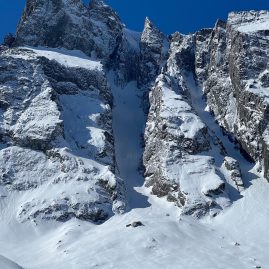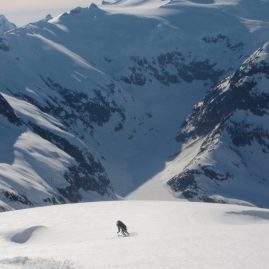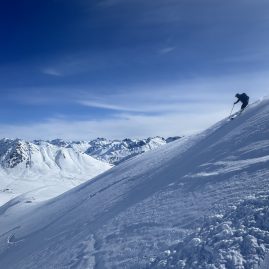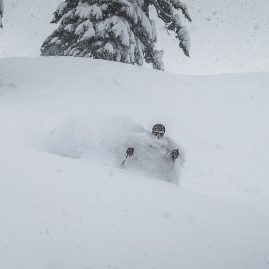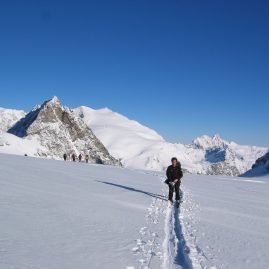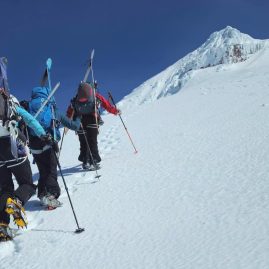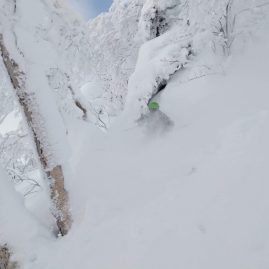The Wapta Traverse is the ‘Haute Route’ of the Rockies with big peaks, enormous glaciers and huts! Cliche and true with moderate terrain, spectacular mountain scenery and peaks begging for ski descents! Simply the best trip to experience your first overnight trip with great huts to keep your loads light and motivation high! The Wapta Traverse serves as a great first Ski-Mountaineering trip and can be a great classroom by spending extra nights at the Peyto and Bow you can learn the skills to ride the volcanoes, try other tours such as the Forbidden, Spearhead and other famous multi day traverses. Many summit descents options exist along the tour with avalanche conditions and physical stamina determine what runs we can do. Summit options are listed under each day with some of the best skiing around both the Peyto and Bow huts.
- 2026 Dates: April 6-10 & Custom Dates Available
- Duration: 5 Days
- Level: Expert to Advanced
- Client Ratio: 4:1
- Cost:
- 5 Day – $1695
- Included: All meals while on the mountain, hut fees, group climbing equipment, and guide services
- Not Included: Ground transportation, airfare, hotel accommodations, restaurant meals, gratuities for guides, and all personal items. A detailed equipment list will be sent to all participants.
Day 1–4,000’/1219m ↑, 6 miles/9.66km, 4-6 hours
Day 2–492’/150m ↑ 984’/300m ↓, 3.7 miles/5.95 km, 3-4 hours
Day 3-1,900’/579m ↑ 1,410’/430m ↓, 4.3 miles/6.92 km, 4-5 hours
Day 4–1,700’/518m ↑ 800’/244m↓, 6.2 miles/10 km, 5-7 hours
Day 5–3,900’/1,190m ↓, 7 miles/11 km, 5-6 hours
Day 0 Lake Louise:6:30pm orientation. After an initial meeting and equipment check, we grab dinner and get to bed early for tomorrow’s big day
Day 1 Skin to Peyto Hut – 4,000’/1219m ↑ | ~6 miles//9.66 km | 4–6 hours
7:30 Drive to Peyto Lake (2,200’) after dropping off the vehicle on the other end of the tour. The tour gains 4,000’ in 6 miles to the Peyto Hut.4-6 hours. The remainder of the day will focus on the skills necessary for the proper use of an ice axe, traveling in balance, self-belay, self-arrest, placing various types of snow protection for use in the construction of snow anchors, as well as belay techniques. We will cap the day with a short evening ski run before dinner.
Day 2 Peyto to Bow Hut(some summits as well..) – 492’/150m ↑ 984’/300m↓ | ~3.7 miles/5.95 km, | 3–4 hours
From Peyto Hut the route ascends southwest onto the Wapta Icefield with Mount Thompson on our left (east) and Rhondda South on your right (west). Ski descents along the route are plentiful. With St. Nicholas in your view dead ahead you will eventually loose elevation and can ski down with towards the Bow hut with St. Nicholas on you right. The tour will be 3-4 hours covering 3.7 miles gaining 492ft, descending 984ft. While traveling we will learn crampon use and climbing steeper snow and ice. We then focus on the skills required for safe and efficient glacier travel including roped travel and self-rescue (prussiking) techniques. This will include the means for each team member to correctly tie into the rope including the proper spacing of climbers based on the number of team members. We will cover the difference in traveling with skis versus snowshoes or crampons, ie when you need to rope up.
Day 3 Bow Hut to Balfour Hut – 1,900’/579m ↑ 1,410’/430m ↓ | 4.3 miles/6.92 km | 4-5 hours
We will spend the first half of the day skiing one ofthe many objectives of Gordon, St Nicholas! then in the afternoon; go Bow Hut to Balfour Hut starts with a steep 1000′ climb up the Wapta Glacier heading west of the Bow hut. Our route offers multiple route options. Ascend the St. Nicholas Peak-Olive col and then ski down the Vulture Glacier. The second option ski tour around the East side of St. Nicholas Peak until you reach the west side of the St. Nicholas Peak-Olive col then ski down the Vulture Glacier to the Balfour hut. 4-5 hours covering 4.3 miles with elevation gain of 1,902ft and descent of 1,410ft.
Day 4 Balfour Hut to the Scott Duncan Hut – 1,700’/518m ↑ 800’/244m ↓| 6.2 miles/10 km | 5-7 hours
Balfour Hut to the Scott Duncan Hut takes us up and over the Balfour High Col, the crux of the Wapta traverse. Exposure to avalanches, ice fall and crevasses. require good weather to gain the upper reaches of the route where things will mellow out a bit and take you away from icefall danger off of Mount Balfour. Ski tour across the High Col till we can remove skins and ski down the Wapituk Glacier to the north-west corner of Mt. Daly. Caution required gaining the ridge for the last climb to the hut. 5-7 hours over 6.2 miles climbing 1,700ft then descending 800ft.
Day 6 Duncan to the Road – 3,900’/1,190m ↓| 7 Miles | 5-6 hours
Leave the Scott Duncan Hut and head toward Mount NIles using the Scheisser/Lomas route which is a 7 mile ski tour to the West Louise Lodge. The descent of 3,900ft takes 5 – 6 hours to complete and in bad weather can be quite challenging. After a few kilometers from the hut, you will come to a small peak go to the right of this and descend down to the westerly shoulder of Mount Niles. Ski through the trees a short distance until you find Sherbrook Creek bed and then follow this out to Sherbrook Lake and cross it to the far end. Ascend the slope on your left and begin searching for the summer trail or remnants of ski tracks which will lead you east around the shoulder of Paget Peak to the West Louise Lodge on Highway 1 a few kilometers away.
Our recommended clothing system has four layers.
- Base layer: manages moisture and wicks perspiration away from your skin. (Polypro, capilene, driclime)
- Softshell: should be a durable, comfortable, insulating and wind/water resistant layer that breathes well.
- Hard shell: windproof, waterproof and breathable. (e.g. Gore-Tex, or similar)
- Insulating layer: should be down-fill or synthetic-fill and fit over all layers. (e.g. down, primaloft or polarguard)
These four layers are usually sufficient for most people, but if you tend to be colder bring one extra medium-layer that would be ideal for extra warmth around camp, such as a vest. When deciding what to pack, remember to bring enough clothes and accessories to ensure your safety and comfort, while not over-burdening yourself with items you probably won’t use.
Climbing/Ski Gear
- Skis or snowboard. Skis should be equipped with alpine touring bindings or telemark bindings. We prefer split decision Snowboards w/ skins because you do not need snow shoes.
- Adjustable Ski Poles
- Alpine touring, telemark, snowboard boots crampon compatible
- Skins
- Ski Crampons Required for all ski mountaineering trips
- Alpine climbing harness Must have adjustable leg loops and fit over all clothing and can be put on with ski boots
- 2 Locking carabiners Large, pear-shaped carabiner is best.
- 2 Regular carabiners lightweight
- 1 Single Length Runner/Sling
- Ice axe Lightweight
- Crampons with anti-ball plate * Must be fit to boots prior to trip,
- Climbing/ski helmet * Adjustable, should fit with hat on
- Glacier Travel/Crevasse Rescue *Optional on Summit Descents Prussiks/Ropeman/Microtraxion & Tibloc
Upper Body
- 1 synthetic T-shirt
- 1 long sleeve Sun Hoodie or shirt Lightweight, light colored for sunny days
- 2 synthetic sports bras*(WOMEN)
- 1 soft shell jacket
- 1 Down/synthetic jacket with hood
- 1 Hard shell jacket with hood Waterproof and breathable. Gore-Tex or equivalent is best, roomy enough to fit over multiple layers.
- 1 pair lightweight gloves
- 1 pair warm waterproof gloves
- Warm hat Wool or synthetic
- Balaclava/Buff
- Shade hat or Visor
Lower Body
- 2 pair med- heavy wool/synthetic socks Check boot fit with liner and wool socks on
- 1 pair lightweight long underwear
- 1-2 pairs of underwear boxers/briefs
- Softshell pants
- Shell pants Waterproof/breathable with full side zips
Sleeping Gear
- Sleeping bag Rated to at least 20º F. Line the stuff sack w/ plastic bag.
- Sleeping pad 1 closed cell foam and/or Neo-Air for extra warmth and comfort.
Backpack
- Internal frame pack 3500-4500 cubic inch capacity able to carry snowboard/skis
Hut Clothes*
- lightweight booties or slippers, comfortable top and bottom-cotton optional.
Miscellaneous Equipment
- Goggles and Glacier glasses 100% UV protection with side shields or wrap around.
- Personal first aid repair kit Basics: moleskin/blister kit, Band-Aids, first-aid tape, ibuprofen, personal medications, spare parts for bindings and batteries etc.
- Lip balm At least SPF 20
- Sunscreen At least SPF 40
- Headlamp lightweight LED
- 2 water bottles 1 liter wide-mouth Nalgene and 1 bottle holster, or
- Hydration bladder With drinking tube and 1 Nalgene bottle
- Toiletry kit Be sure to include WAG Bag or toilet paper stored in a plastic bag.
- 1-2 Large plastic bags Good for keeping miscellaneous gear dry
- Nylon stuff sacks For food and gear storage (large Ziplocs are also useful
- Bandana
- Hand wipes
- 1 small stainless steel thermos (Optional)
- Favorite snack foods (no more than 2 pounds)
- Camera
WILL MY GUIDE (OR GUIDES) BE?
We are a small company who enjoy working together in the mountains as well as highly skilled professionals who hold current Wilderness First Responder certification and are proficient in technical rescue and evacuation skills. Our guides are dedicated to the world of alpinism, many having first ascents and hold professional certifications with the AMGA in the rock, alpine, and ski disciplines. The AMGA is part of the IFMGA, which is the international body of certified mountain guides.
HOW MUCH SHOULD I TIP MY GUIDES?
Tipping is considered standard practice in the guiding industry. Tipping amounts vary, often 10% of the course cost is a good rule-of-thumb, so $20-30 per day per person/per guide is an average that works well for the guides without a serious blow to your wallet. If you feel that the program was exceptional or substandard the tip can reflect that.
CAN I RENT EQUIPMENT FROM BCAG?
No, we recommend renting from Ascent Outdoors where they have a full selection of rentals.
HOW HEAVY WILL MY PACK BE?
You will be required to carry a portion of the group gear and food in addition to your personal gear. This should be taken into consideration when deciding what you will bring. A good rule of thumb is to try to keep your pack weight below 40 pounds, which will allow for extra items to be carried of the group equipment.
WHEN DO I NEED TO PAY THE BALANCE OF MY TRIP?
For Scheduled International Courses and Climbs: Your balance is due 60 days from trip departure. Payable by credit card, check, Venmo or Paypal.
WHAT HAPPENS IF I NEED TO CANCEL MY TRIP?
If you decide to cancel your trip, BCAG must be notified in writing. Your trip will be canceled from the date we receive written notice. You will be assessed a cancellation fee according to the following schedule: 90 to 31 days from trip departure – 50% of trip cost 30 days or less – 100% of trip cost
WHAT HAPPENS IF I WANT TO CHANGE THE DATES OF MY TRIP?
Schedule changes are subject to a $100 fee per person up to 2 weeks out and $150 less than 14 days from the start of the trip and may not be possible. If conditions or circumstances preclude running a scheduled program we reserve the right to make the decision as to whether the program will be canceled, rescheduled, or an alternative provided.
WHAT HAPPENS IF BC ADVENTURE GUIDES HAS TO CANCEL MY TRIP?
In the rare circumstance where we need to cancel a program you can reschedule without a fee or receive a refund on your deposit. If circumstances arise that force us to cancel a program that is already in progress we reserve the right to decide whether a refund or credit, at a prorated rate, will be issued. We are not responsible for cancellation fees or costs arising from your changed or cancelled flights, lodging, or other arrangements. We strongly recommend obtaining trip cancellation insurance from your travel agent.
DO I NEED TO PURCHASE TRIP INSURANCE? BCAG highly encourages the purchasing of trip cancellation and travel insurance on domestic trips and requires it on international trips. Europeans and Canadians use it because travel insurance provides coverage for trip cancellation and interruption, travel delays, loss of baggage and travel documents, baggage delays, medical expenses and emergency assistance. To avoid any financial hardship that an unexpected cancellation or interruption could cause, Trip Cancellation/Interruption costs about 5% of your trip cost and it’s worth the peace of mind! If you find that you are not already covered for any of the above circumstances you have options! BCAG has an account with Global Rescue, the world’s leading membership organization providing integrated medical, security, travel risk and crisis response services to our travelers worldwide. They can provide you with medical and evacuation coverage. https://partner.globalrescue.com/bcadventureguides/index.html
WHEN SHOULD I PLAN TO LEAVE A RETURN HOME?
We often get this question because most people need to know how much total time they need to take off work. Our return to the car will be mid to late afternoon so the last day typically allows you to get back to your car around 3-6pm so we recommend staying in a hotel near the airport your are flying out of or hit one of the hotsprings on your way back to Seattle.


